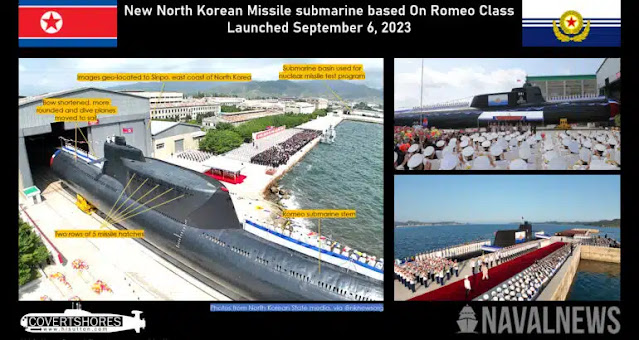I’ve been casting a net to confidential contacts on the issue of South
Korea (SK) converting its conventionally missile armed KSS-IIIs to subs providing
a nuclear deterrent. The following are their responses, speaking under protection of anonymity:
South Korea: We SK politicians and public are increasingly positive about building our own nuclear deterrent. This is because any nuclear free
Korean peninsula policy is now an out of date fantasy. A Trump or even an isolationist
Democrat win in the 2024 US Elections is too much of a (remove the US nuclear umbrella) risk to our homeland.
We more than realize that our KSS-IIIs are the only SSBs (which stands for conventionally propelled submarines (SS) armed with Ballistic missiles) in history that are not nuclear armed. Also all SLBMs (except ours, so far) have been nuclear armed. Historically Soviet SSBs were nuclear armed and it is strongly suspected Israel's INS Drakon and then Dakar-class will have SLBMs that are nuclear armed.
We may have a joint program with Israel for developing an SLBM.
UK and France: We great-middle powers see submarines as the most reliable nuclear weapons delivery platforms. This is because the other 2 launch modes: air bases (for nuclear
armed aircraft) and land based missile silos (on countries like ours with small land areas) can be “taken out” within a few minutes by enemy first
strikes.
South Korea: Our country, SK, suffers from having a small land area and sharing a border with our main threat,
North Korean (NK). This means NK could launch a disarming nuclear first
strike (taking out our air bases and any missile silos) in less than 10 minutes. So viable second strike deterrents must be SSBs that are difficult for NK and any other country to find.
Developing boosted fission weapons is a much higher priority than developing nuclear propulsion for subs.
China: We are concerned that once SK publicizes its
nuclear deterrent (or the SK "Bomb" is revealed by espionage) this will have unwelcome impacts on NK and Japan.
We may not
be able to restrain NK from taking violent and unpredictable nuclear and/or conventional military actions
against SK. A Korean nuclear war on our doorstep could mean radiation blowing into highly populated northeast China and a large Korean refugee problem streaming over the border.
Japan: We are a rival to SK. A nuclear armed SK would remove the "nuclear taboo" limiting our nuclear weapons proliferation. We will likely and eventually react, on hearing about a nuclear SK, by publicizing our own nuclear weapons,
capabilities or plans. We realize that China may be somewhat concerned about a militarily resurgent nuclear armed Japan, but we will always be weaker than China.
Russia: Rolling nuclear weapons proliferation that includes SK and Japan will raise tensions in China and NK to our south. We border China and North Korea. Chinese nuclear weapons growth might accelerate. While we are currently friends with China we are also regional and world political rivals. We don't want that rivalry to become a nuclear and conventional arms race with China. We also don't want nuclear or even conventional war in the Korean Peninsula.
We don't want to be drawn into northeast Asian conflicts while we are fighting in what we insist are dissident, NATO proxy, Russian territories like Ukraine, Finland and other naturally Russian Baltic states. Also northeast Asian conflicts would be bad for our oil and gas exporting businesses.
Australia: If SK and Japan publicize their nuclear weapons capability we will eventually publicize ours. Our future SSNs, when armed with better missiles than Tomahawks, will be our logical nuclear weapons platforms.
US: Who knows?! Our views depend on whether we get Trump back. Biden's lead over Trump has "evaporated". God help us! I'm also not sure our aging Biden, a steady hand on SK, will contest the November 2024 presidential election.










.png)
